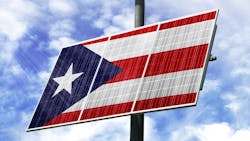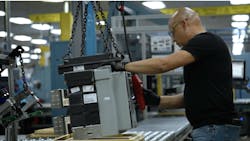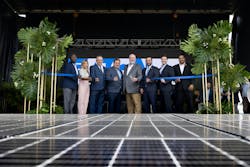Eaton’s energy-as-a-service microgrid: A model for sustainable energy and disaster resilience
Earlier this year, Eaton and its partner Enel North America completed a clean energy project at Eaton’s manufacturing facility in Arecibo, Puerto Rico, and is soon ready to break ground on a new project in the country. At the Arecibo plant, Eaton makes circuit breakers, which play a critical role in the supply chain for electronics in the region (Figure 1). Driven largely by the region’s high energy costs and the risk of severe weather, the Arecibo manufacturing facility was clear choice for a microgrid-plus-storage project. The microgrid system of 5-megawatt solar photovoltaic (PV) arrays, approximately 1.1 MW of battery storage, and existing on-site generators support more than half of the facility’s energy needs. The system is expected to generate more than 9,000 MW of renewable power annually.
Eaton has undertaken a number of solar projects since 2009, as part of its own commitment to climate change and reducing company carbon emissions by 50% by 2030. In 2017, Hurricane Maria devastated Puerto Rico, and Eaton took note of the value of storage in a microgrid, so the facility could stand on its own.
The Arecibo microgrid infrastructure is ultimately built to withstand a Category 5 hurricane or winds in excess of 157 miles per hour and can sustain itself as an island, if infrastructure is down elsewhere. “It can be separated from the grid, if the grid is down, and we can be self-reliant through the storage, the microgrid and the backup generators and be able to power the site,” says Richard Gorzé, senior global energy manager at Eaton.
Power as a two-way street
As a power management company, Eaton understands the infrastructure for producing power, from building the equipment that supports electrical, hydraulic and mechanical power to solutions and approaches for reducing the cost and environmental impact of energy at its own facilities and its customers.
“Everything as a Grid” is Eaton’s approach to the future of energy, putting its stamp on reinventing the way power is distributed, stored, and consumed. The power grid traditionally has run in one direction, where power from the utility is produced at a centralized source and flows in one direction to consumers. Now, with microgrid infrastructure, consumers can produce and store their own energy and send it back to the grid, creating a two-way street for power. Eaton says this decentralization of power creates challenges but also decarbonization potential.
The company’s 2030 climate change targets also include lowering product and supply chain emissions and certifying all manufacturing sites as zero waste to landfills. The company has a multi-faceted environmental approach that includes energy efficiency initiatives, plant engagement to reduce energy usage, on-site solar projects, off-site renewable energy sourcing, and green supply contracts.
“At Eaton, we’ve been helping customers safely add more renewables, storage, and electric vehicle infrastructure to their energy mix—to become more sustainable and resilient while lowering energy costs. By helping create these flexible energy systems, we’re ensuring power infrastructure can meet the needs of today and tomorrow while accelerating decarbonization, boosting resilience, reducing energy costs, and creating new revenue streams,” Gorzé says.
Energy-as-a-service model
Initial plans for an on-site solar microgrid project with storage at Arecibo were announced in 2020 (Figure 2). “With a microgrid system incorporating solar plus storage, as well as our existing on-site generators, we were able to create a robust energy infrastructure that’s prepared to withstand the impact from extreme weather events,” Gorzé says. The complex project did take significant time to get the proper approvals from many parties, including Luma, the host utility in Puerto Rico, local government approvals and an agreement with Enel North America, a clean energy developer and operator.
“In a project like this, again, it doesn't happen overnight, so there's quite a bit of work once you get the internal approvals from leadership to move forward on a project,” Gorzé says. “This being the first of its kind type of project, with solar storage and microgrid, even the utility still needed to understand all that was involved, because it was new to them.”
Clean energy developer and operator Enel North America worked with Eaton to create the long-term financial agreement, or power purchase agreement (PPA). Eaton noted Enel’s flexibility as a key to the project’s success. For facilities that don’t want or can’t make a long-term capital expenditure (Capex), as-a-service models can be a different way to structure investment from Capex to Opex (operational expense).
“Together, we developed an energy-as-a-service model that made sense for this project. Enel North America built, owns, and operates the system on our behalf. We were able to shift our investment in the microgrid from a capital to an operational expense,” Gorzé says. Eaton also provided installation expertise and key technologies for the microgrid system, including its Power Xpert microgrid controller, switchgear, and other power distribution equipment.
The primary challenge during installation was ensuring the microgrid system’s control architecture is optimized, and all components are working in sync (Figure 2). “Post-commissioning tuning is essential to support system sensitivity and synchronization,” Gorzé says. “Maintenance includes evaluating and upgrading decades-old switchgear to ensure compatibility and reliability. For example, we replaced existing switchgear at the site to handle the solar input, and the equipment costs can be rolled into the PPA financing.”
To manage the intermittency of renewables, a solar-plus storage microgrid integrates solar PV generation with energy storage systems and microgrid control over energy supply. Eaton’s microgrid controller balances electricity consumption by analyzing real-time energy needs at the facility, in deciding between using or storing solar energy. Those systems and components all need fine-tuning or sensitivity analysis, Gorzé says. “We have to do some of that fine tuning to make sure the systems are all communicating and working together,” he adds. “There are a number of tests we do to qualify it after it goes live, as well as how it interconnects with the utility.”
Eaton says the project is projected to reduce energy consumption at the plant by 45%, cut emissions by 7,100 metric tons annually and reduce energy costs by 20%.
Hurricane-proof
The PV modules and all the equipment bringing power from the solar panels to the facility or the utility also had to be hurricane-resistant, impenetrable against a Category 5 storm. The mounting system would need to withstand immense wind loads, which will generally cause the most damage in a hurricane. The precise design is very location-specific, considering the local environment and historical wind data, panel tilt, the distance from the roof or foundation, racking material, and bracing type.
“In Arecibo, we went well beyond requirements and implemented steel bracing structures for the solar arrays that are anchored eight feet in the ground to ensure resilience,” Gorzé says. Generators and battery banks are also enclosed within reinforced structures, which meet local building code requirements for wind bracing, structural engineering, and rooftop weight.
Most importantly, the foundation and support structures for any microgrid components must be hurricane-rated. This can be challenging with an existing rooftop retrofit, Gorzé says. “Structurally reinforcing an existing rooftop is often cost-prohibitive, so ground-mounted PV installations on a reinforced concrete pad designed for the local environment are common,” he adds. All 19,100 panels across 15 acres at the Arecibo facility are ground mounted.
More solar
In September, Eaton received the 2024 International Energy Project of the Year award from the Association of Energy Engineers (AEE) (Figure 3), and Gorzé was named an AEE fellow member, highlighting his contributions to the association and the energy industry. Gorzé accepted the award and AEE honor at the 2024 AEE World Energy Conference & Expo on September 25.
Eaton has been dabbling in solar power projects for a decade and a half, and following the success of the Arecibo project, it has already announced another clean energy microgrid project at Eaton’s Las Piedras manufacturing facility in Puerto Rico.
About the Author

Anna Townshend
managing editor
Anna Townshend has been a journalist and editor for almost 20 years. She joined Control Design and Plant Services as managing editor in June 2020. Previously, for more than 10 years, she was the editor of Marina Dock Age and International Dredging Review. In addition to writing and editing thousands of articles in her career, she has been an active speaker on industry panels and presentations, as well as host for the Tool Belt and Control Intelligence podcasts. Email her at [email protected].




